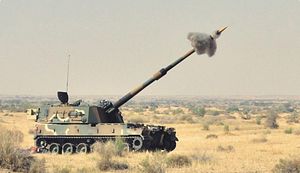India’s Cabinet Committee of Security (CCS), a government body headed by Indian Prime Minister Narendra Modi and responsible for military procurements, has reportedly approved the purchase of 100 modified K-9 Vajra 155 mm/52 caliber self-propelled tracked howitzers for the Indian Army on March 31.
A contract between the Indian Ministry of Defense (MOD) and the howitzer’s maker, South Korea’s Samsung-Techwin, along with its local Indian private-sector partner Larsen & Toubro (L&T), was expected to be signed at a L&T plant near Pune this week. Neither the Indian government nor L&T have so far publicly confirmed that the estimated $750 million deal is moving forward.
The Indian military selected the self-propelled howitzer in September 2015 after the completion of maintenance acceptability, high altitude, and desert trials, which took place in 2013 and 2014. The K-9 Vajra was selected over the Russian-made 2S19 Msta-S howitzer, which had been specifically modified with a 155mm/52 caliber gun to fit Indian Army requirements, but lost out nonetheless.
The Indian MoD only concluded price negotiation with L&T in July 2016.
The howitzers are procured under the under the “Buy Global” category of the so-called Defense Procurement Procedure (DPP), which allows over-the-counter sales of military hardware and bypasses the 30 percent offset investment clause mandated by the Indian government for most foreign military hardware purchases.
In lieu of the 30 percent offset investment of the overall contract value, the Samsung-Techwin/L&T joint venture agreed that 50 percent of the K-9’s hardware — 14 subsystems, including fire control and communication suites — will be domestically produced by L&T.
The K-9 Vajra 155 mm/52 caliber self-propelled tracked howitzer is a modified version of the Samsung-Techwin K-9 155 mm/52-caliber, and has an operational range of 450 kilometers (279 miles). It can engage enemy targets at a distance of up to 40 kilometers (24 miles). As I noted elsewhere:
The K-9 Vajra is specially designed for arid lands such as the desert areas bordering Pakistan. Mounted on a tracked vehicle, the K-9 Vajra is ideally suited for mobile tank warfare. (…)
The Indian Army wants to induct this new howitzer into its mechanized strike corps to offer close fire support during deep thrusts into enemy territory. (…)
The overall number of K-9 Vajra required by the Indian Army will be around 250. This is based on the creation of at least three K-9 Vajra regiments for each of the army’s three armored divisions, as well as another three regiments for the independent armored brigades within the army’s three strike corps. [The Indian Army decided to disaggregate the three strike corps into division-sized integrated battle groups and station them closer to the border.]
While the Indian Army’s requirement is for 250 new howitzers, IHS Jane’s Defense Weekly notes that the current contract only includes the option for an additional 50 guns.
The induction of self-propelled howitzers appears to be part of the Indian military’s slow implementation of its so-called Cold Start Doctrine of limited conventional war with Pakistan. The doctrine, which until recently has not been officially acknowledged to exist by the Indian government, calls for “limited but rapid armored thrusts into Pakistani territory supported by mechanized infantry formations and air power within 48-72 hours at the outset of a military confrontation with Islamabad,” as I noted elsewhere.
































